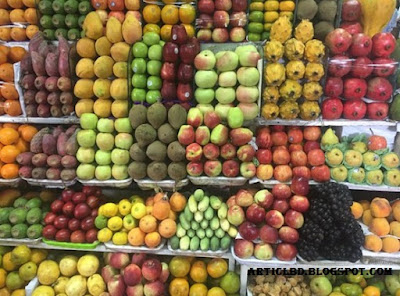Seasonal Fruits Contain
Many many fruits, including fleshy fruits (like apple, kiwifruit, mango, peach, pear jakfrut, and watermelon) are commercially valuable as human food, eaten both fresh and as jams, marmalade and other preserves. Fruits also are utilized in manufactured foods (e.g., cakes, cookies, ice cream, muffins, or yogurt) or beverages, like fruit juices (e.g., fruit juice , fruit juice , or orange juice) or alcoholic beverages (e.g., brandy, fruit beer, or wine).[30] Fruits also are used for gift giving, e.g., within the sort of Fruit Baskets and Fruit Bouquets.
Storage
All fruits enjoy proper post harvest care, and in many fruits, the phytohormone ethylene causes ripening. Therefore, maintaining most fruits in an efficient cold chain is perfect for post harvest storage, with the aim of extending and ensuring time period .[33]
Each point refers to a 100 g serving of the fresh fruit, the daily recommended allowance of vitamin C is on the X axis and mg of Potassium (K) on the Y (offset by 100 mg which each fruit has) and therefore the size of the disk represents amount of fiber (key in upper right). Watermelon, which has almost no fiber, and low levels of vitamin C and potassium, comes in last place. If you try it.
As excessive intake of added sugar is harmful and fruits are relatively high in sugar it's often questioned whether fruits are literally healthy food. it's actually difficult to urge excessive amounts of sugar (e. g. fructose) from fruits as they also contain fibers, water and have significant chewing resistance. an summary on numerous studies are often found here.[34] Studies show that fruits are very satisfying (for example apples or oranges).[35] additionally , the fibres contained in fruits promote satiety[36] and help lose weight[37] and have cholesterol-lowering effects.[38]
Fresh fruits are generally high in fiber, vitamin C, and water.
Regular consumption of fruit is usually related to reduced risks of several diseases and functional declines related to aging. A current review of meta-analyses even involves the conclusion that current assessments might even significantly underestimate the protective associations of fruit and vegetable intakes.
Food safety
For food safety, the CDC recommends proper fruit handling and preparation to scale back the danger of food contamination and foodborne illness. Fresh fruits and vegetables should be carefully selected; at the shop , they ought to not be damaged or bruised; and precut pieces should be refrigerated or surrounded by ice.
All fruits and vegetables should be rinsed before eating. This recommendation also applies to supply with rinds or skins that aren't eaten. It should be done just before preparing or eating to avoid premature spoilage.
Fruits and vegetables should be kept break away raw foods like meat, poultry, and seafood, also as from utensils that have are available contact with raw foods. Fruits and vegetables that aren't getting to be cooked should be thrown away if they need touched meat , poultry, seafood, or eggs.
All cut, peeled, or cooked fruits and vegetables should be refrigerated within two hours. After a particular time, harmful bacteria may grow on them and increase the danger of foodborne illness.
Allergies









Growing up we had dairy dinners– fish, or pasta– and were given milk to drink. On meat dinners- we had juice or water. Never soda. One night- for dairy dinner– my mother served waffles and ice cream with hot fudge and wet nuts. and that became a regular treat.
ReplyDeleteSo now that I have children- when we were at a NJ shore vacation, we always went at least once a summer for Dairy Dinner– and I often served it at home. Now that my kids are in their twenties- they think they are too grown up for dairy dinner– So once a summer , at least, my 60 something girlfriend and I go out for Dairy Dinner– coffee ice cream, fresh waffles, hot fudge, and wet dinner. My daughter knows that my new granddaughter will behaving dairy dinner
My niece- at age 8- was invited to stay for dinner at a friend’s house for dairy dinner She started to sob, when dinner of flounder was served. Not the dairy dinner she expected that her mom learned to serve. We still joke about her failed Dairy Dinner
Hi Dear, Growing up we had dairy dinners– fish, or pasta– and were given milk to drink. On meat dinners- we had juice or water. Never soda. One night- for dairy dinner– my mother served waffles and ice cream with hot fudge and wet nuts. and that became a regular treat.
ReplyDeleteMy niece- at age 8- was invited to stay for dinner at a friend’s house for dairy dinner She started to sob, when dinner of flounder was served. Not the dairy dinner she expected that her mom learned to serve. We still joke about her failed Dairy Dinner